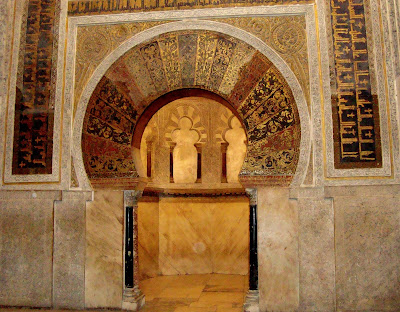 |
| The mihrab at the mezquita-catedral in Córdoba features a horseshoe arch. |
When I brought the book to my critique group, which consists of great writers who happen to lack an interest in historical novels, more often than not, they found it accessible. If there were terms or circumstances particular to tenth-century Spain, I went back and explained them enough to keep an uninitiated reader up to speed without slowing the story down. So that anxiety waned and I pounded out the rest of the book without that internal editor.
Then my husband read it. He's now working in retail, which has shaken his faith in humans' ability to rise to an occasion. He thinks some of the "big" words I use will put readers off and recommends cutting them.
The thing is, sometimes, especially in a historical context, the "big" word is the right word.
The most passionate debate came about because of a couple of architectural terms at the end of the book. Our hero notices a polylobed arch where there was none before. My husband stumbled over "polylobed" and passionately defended its execution. Do you know what a polylobed arch is? If you didn't, did the word's use in the sentence upset you?
A polylobed arch is an arch with many lobes, as seen in this picture. I don't know of any other word that would distinguish this style from other types of arches, so it must be the right word.
Normally I wouldn't put up a fight about something so small, but I want to leave this word in because earlier on the same page, the hero notices a horseshoe arch. That's also a technical term, but my husband didn't reject it because it's more intuitive. It wouldn't be easy to create the same effect without the word "polylobed": "a horseshoe arch here... and an arch over there."
The use of this word didn't bother my editor. My critique group hasn't gotten to the end of the book yet, so their jury's still out. What do you think? Is this an example of a word that's too "big"? Or is it just the right word?


I like the use of 'technical' terms. My tendency would be to use a footnote to explain it. Don't dumb it down!
ReplyDeleteAnd thank you for the post. I know quite a bit aboaut architecture and see those arches frequently in my own synagogue (Central Synagogue, in New York City) but didn't know the term.
Thanks for stopping by, Patricia! I hesitate to put a footnote in a novel. Authors like Nabokov and Stroud have used them, but only to hilarious-- never serious-- effect. Have you used footnotes in your fiction?
ReplyDeleteAnother option could be a glossary, but since I've made such an effort in the rest of the book to be accessible, it would be awfully short.
It's just the right word... Yes, it's less intuitive than horseshoe, but it's not in a foreign language or impossible to deduce. True, without the image above, I wouldn't have had a precise visual image, but poly and lobe together get me at least halfway there. And unless the novel is about architecture and polylobed arches play a significant role in the plot, I wouldn't fuss about it too much as a reader -- unless it were one of many examples of highly technical terms. Explain some of the terminology in the author's note, if you want.
ReplyDeleteThis comment has been removed by the author.
DeleteThanks for this dose of sanity, Suzanne! I assumed most readers could put poly and lobe together, too, before it came up against such vehement objections.
Delete